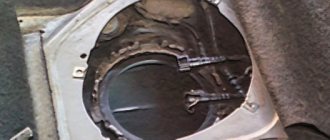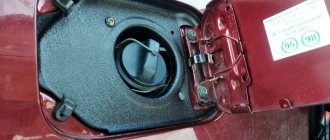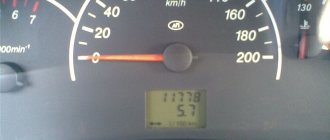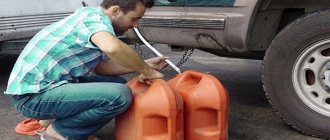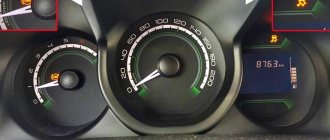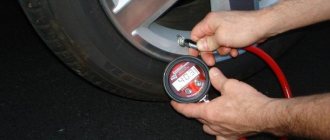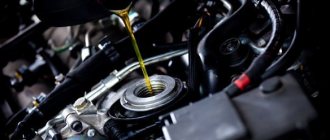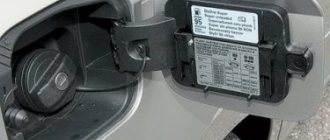In the life of car enthusiasts, in some cases there is a need to urgently drain gasoline from the tank. For example, when the wrong gasoline was poured into the tank, or the quality of the fuel is very poor, or the gasoline needs to be drained to repair the fuel system. We offer you several simple ways to drain gasoline from the tank of a modern car.
The essence of the problem is that if draining fuel from the tanks of old domestic cars and foreign cars does not cause difficulties, then, for example, in modern VAZ models with an injector, a special filter mesh located in the filler neck of the gas tank prevents draining gasoline. This mesh serves not only as a filter, but also as a good protection against thieves, preventing a hose from being inserted into the tank through the neck and draining gasoline.
Most often, the need to drain gasoline from the tank occurs in the following foreign cars and VAZ cars:
- Renault Logan, Ford Focus, Chevrolet Lanos and Niva;
- Lada: Granta, Kalina, Priora;
- VAZ: 2109, 2110, 2114 and 2115.
For a visual video on how to drain gasoline from the tank of a VAZ car with an injector, see the end of the article.
Ways to drain gasoline from the tank of a foreign car
If your car has a mesh installed in the gas tank, and you can’t drain the gasoline with a hose, don’t worry. There are several other simple ways to drain fuel from the gas tank of a foreign car.
In any case, it is worth remembering that gasoline should only be drained from the tank in an open area, so as not to be poisoned by fuel vapors, which are very harmful to human health.
Method 1
Many modern cars have a special drain hole at the bottom of the gas tank that allows you to completely drain all the fuel from the tank. You just need to find this hole, place a suitable container under it and, unscrewing the cap, pour gasoline into it.
This method is very simple, but not all cars have drain holes, and crawling under the car is not always convenient. Therefore, we will consider another option, how to drain gasoline from the tank of a foreign car.
Method 2
In order to drain gasoline from the tank of a foreign car, you need to perform a few simple steps:
- Open the hood of your car;
- With the engine off, disconnect the fuel hose (coming from the fuel pump) at its connection to the engine.
- Place the freed end of the hose into a suitable container for draining gasoline from the tank (bottle, canister, etc.).
- Turn on the car's ignition, but DO NOT START the engine! In this case, the fuel pump will turn on for a few seconds and pump fuel. Thus, by turning the ignition on and off several times, you can drain a sufficient amount of gasoline from the fuel tank.
- After you have drained the required amount of gasoline, the fuel hose should be reconnected to the engine.
FakeHeader
Comments 21
The tank is exactly 50 liters - tested on a stalled car by filling it up to the neck. And they simply inject you with gasoline. All tanks are the same, because... in the molds of a part such as a tank, there cannot be an error of more than 100 grams.
After a full tank, when the first light goes out
somehow I didn’t notice, but if on the highway it takes a very long time, and then abruptly. This is an incorrect operation of the on-board driver. just like when parking on a slope or with the car running, refuel.
I've driven 200 km through the city in Japan and not a single stick has fallen yet
The tank is exactly 50 liters - tested on a stalled car by filling it up to the neck. And they simply inject you with gasoline. All tanks are the same, because... in the molds of a part such as a tank, there cannot be an error of more than 100 grams.
Golimaya nonsense, the tank on the Largus is under the throat, about 65 liters, I measured it myself with a canister!
It’s strange, when I have 9-10 liters left (according to BC), 40 liters can hardly fit in. If the remainder is 11, then about a liter does not fit, it snaps off and flows from the neck along the wing.
Reasons for draining gasoline
To force a driver to drain fuel from a car, there must be compelling reasons. Let's consider the main ones:
- The need to repair the vehicle. This could be due to a traffic accident or planned restoration of body parts. For safety reasons, the fuel tank is removed, and then the fuel is drained.
- Cleaning the fuel system and gas tank. To clean the system, automotive chemicals are often used, and therefore it is worth removing fuel from the entire system.
- Replacing or repairing a gas tank is one of the reasons why you may need to drain the fuel.
Gas tank capacity in Largus
| Options | "Universal" 7-seater | "Universal" 5-seater | "Van" | |||
| K4M/21129/ JR5 | 11189/JR5 | K4M/21129/ JR5 | 11189/JR5 | K4M/21129/ JR5 | 11189/JR5 | |
| "Luxe" | "Norma" | "Luxe" | "Standard" "Norma" | "Luxe" | "Standard" "Norma" | |
| Engine capacity | 1.6 l 16V | 1.6 l 8V | 1.6 l 16V | 1.6 l 8V | 1.6 l 16V | 1.6 l 8V |
| Number of doors | 6 | |||||
| Length, mm | 4470 | |||||
| Width, mm | 1750 | |||||
| Height without roof rails (at curb weight), mm | — | 1650 | ||||
| Height with roof rails (at curb weight), mm | 1670 | — | ||||
| Base, mm | 2905 | 2905 | ||||
| Front track, mm | 1469 | 1468 | ||||
| Rear track, mm | 1466 | 1466 | ||||
| Front overhang, mm | 795 | 795 | ||||
| Rear overhang, mm | 770 | 770 | ||||
| Ground clearance at full weight, mm | 145 (minimum ground clearance corresponds to the point under the engine mudguards) | |||||
| Trunk volume (VDA), dm3 | 135 | 560 | 2540 | |||
| Weight of the vehicle in running order, kg**, with driver | 1330… 1370 | 1260… 1345 | 1260…1275 | |||
| Permitted maximum weight (technically permissible), kg | 1810… 1850 | 1705… 1790 | 1985… 2000 | |||
| Maximum weight on the front axle (technically permissible), kg | 930 | 940 | ||||
| Maximum weight on the rear axle (technically permissible), kg | 1080 | 1160 | ||||
| Permissible total weight of a towed trailer, not equipped with brakes, kg | 650 (420 for a car without ABS) | |||||
| Permissible total weight of a towed trailer equipped with brakes, kg | 1300 | 1300 | 1300 | — | ||
| Permitted maximum weight with trailer, kg | 2650 | 2650 | 2650 | 2600 | ||
| Permissible load on the coupling device, kg | 75 | |||||
| Permissible load on the roof rack (including the weight of the rack), kg | 80 | |||||
| Maximum speed, km/h*** | 165 | 158 | 165 | 158 | 165 | 158 |
| Acceleration 0-100 km/h, s*** | 13,5 | 14,4 | 13,1 | 14,2 | 14,0 | 15,4 |
| Fuel consumption, l/100 km (combined cycle) | 9,0 | 9,5 | 9,0 | 9,3 | 9,0 | 9,3 |
| Wheels | 6.0 J15 | |||||
| Tires | 185/65R15 | |||||
| Turning diameter according to clearance, m | 11,25 | |||||
| Fuel tank volume, l | 50 |
When loading a vehicle to its full weight, the weight of the trailer should not lead to excess weight of the road train.** The curb weight indicated in this table corresponds to the weight of an empty vehicle.*** Technical characteristics are measured using special methods, serve for comparison of different vehicles and operating standards they are not!
| Options | "Universal" 7-seater | "Universal" 5-seater | "Van" | |||
| K4M/21129/ JR5 | 11189/JR5 | K4M/21129/ JR5 | 11189/JR5 | K4M/21129/ JR5 | 11189/JR5 | |
| "Luxe" | "Norma" | "Luxe" | "Standard" "Norma" | "Luxe" | "Standard" "Norma" | |
| Engine capacity | 1.6 l 16V | 1.6 l 8V | 1.6 l 16V | 1.6 l 8V | 1.6 l 16V | 1.6 l 8V |
| Number of doors | 6 | |||||
| Length, mm | 4470 | |||||
| Width, mm | 1750 | |||||
| Height without roof rails (at curb weight), mm | — | 1650 | ||||
| Height with roof rails (at curb weight), mm | 1670 | — | ||||
| Base, mm | 2905 | 2905 | ||||
| Front track, mm | 1469 | 1468 | ||||
| Rear track, mm | 1466 | 1466 | ||||
| Front overhang, mm | 795 | 795 | ||||
| Rear overhang, mm | 770 | 770 | ||||
| Ground clearance at full weight, mm | 145 (minimum ground clearance corresponds to the point under the engine mudguards) | |||||
| Trunk volume (VDA), dm3 | 135 | 560 | 2540 | |||
| Weight of the vehicle in running order, kg**, with driver | 1330… 1370 | 1260… 1345 | 1260…1275 | |||
| Permitted maximum weight (technically permissible), kg | 1810… 1850 | 1705… 1790 | 1985… 2000 | |||
| Maximum weight on the front axle (technically permissible), kg | 930 | 940 | ||||
| Maximum weight on the rear axle (technically permissible), kg | 1080 | 1160 | ||||
| Permissible total weight of a towed trailer, not equipped with brakes, kg | 650 (420 for a car without ABS) | |||||
| Permissible total weight of a towed trailer equipped with brakes, kg | 1300 | 1300 | 1300 | — | ||
| Permitted maximum weight with trailer, kg | 2650 | 2650 | 2650 | 2600 | ||
| Permissible load on the coupling device, kg | 75 | |||||
| Permissible load on the roof rack (including the weight of the rack), kg | 80 | |||||
| Maximum speed, km/h*** | 165 | 158 | 165 | 158 | 165 | 158 |
| Acceleration 0-100 km/h, s*** | 13,5 | 14,4 | 13,1 | 14,2 | 14,0 | 15,4 |
| Fuel consumption, l/100 km (combined cycle) | 9,0 | 9,5 | 9,0 | 9,3 | 9,0 | 9,3 |
| Wheels | 6.0 J15 | |||||
| Tires | 185/65R15 | |||||
| Turning diameter according to clearance, m | 11,25 | |||||
| Fuel tank volume, l | 50 |
We drain gasoline from the “classic”
How to drain gasoline from a VAZ “classic”? This is the simplest and most proven method, which was used by our grandfathers. To carry out the operation, you will need a hose that will fit into the filler neck. Beginning car enthusiasts may be faced with the question of how to drain gasoline with a hose. The operation is quite simple:
- Unscrew the filler plug.
- We insert the hose through the hole so that it reaches the bottom of the fuel tank.
- Now you need to slightly pull the air from the back of the tube toward you and sharply insert the hose into the container.
- Thus, gasoline should flow.
You should be extremely careful because you can draw in too much air along with fuel that enters the body. This can lead to the most dire consequences.
After the fuel remains at the bottom of the fuel tank, you can remove the hose and remove the container to carry out the remaining manipulations. This method was often used by thieves who drained fuel from the car at night.
Design
Regardless of the factor, what kind of car you own and what tank you drain, you will still be faced with a single concept. It will not be the case that in one machine everything happens one way, and in another - according to a different method. Everything is done the same for everyone. Each fuel tank of a regular passenger car or SUV has its own capacity. Some have 20 liters, others have 100 or more. This doesn't matter at all. Each tank is closed tightly using a regular lid called a “screw” lid. Thus, fuel does not leak out of the tank anywhere and, of course, does not simply drain into the external environment. It just burns off and the internal combustion engine uses it to keep your car going on the road.
How to drain gasoline from a Lada Priora
Unlike “classics”, on modern cars it is no longer possible to drain fuel through the neck of the fuel tank, since there are protections. It is simply not possible to stretch the hose inside the tank and “suck out” the fuel. Then how to drain gasoline? Other methods are used for this.
For this type of car there are two ways to solve the problem. The first option involves wedging into the fuel line in the area of the fuel filter. The second is dismantling the fuel pump. Let's look at each method step by step.
Part replacement features
Replacing this part is not so difficult if you know where the fuel filter is located on the Largus and how to carry out the repair correctly
It is important to note that even an amateur motorist can perform the replacement procedure, since the whole process is very simple. Replacing the filter does not require any serious preparation, except for the following measures:
- It is best to replace the filter element in a spacious workshop, where the car can be parked on level ground, securely fixing it with a handbrake or a wheel stand;
- prepare in advance a standard car repair kit: several screwdrivers, a set of keys, rags and gloves;
- buy a fuel pump assembly or a separate fuel pump “mesh” (for example, the same part will do, but only from Renault Logan).
The procedure itself takes no more than 30 minutes, of course, if you do not want to completely disassemble the fuel pump system and try old-fashioned methods to clean the fuel filter. Replacing the part with a homemade filter is considered a bad idea. Also, this should not be done because incorrectly cleaning or assembling the fuel pump will cause serious damage to the entire Lada Largus fuel system. Is it worth it? Most likely no.
Other ways to drain gasoline from a vehicle
On some cars of the Lada family, where the fuel tank is located under the luggage compartment, there is a fuel drain bolt. This happened on the first generations of Priora and Granta. It served precisely so that, if necessary, fuel could be drained from the fuel tank. The procedure is quite simple: we place the container and unscrew the bolt with a 17 key. But later this mechanism was removed.
Another option is to drain through the fuel rail. First, the fuel supply hose is unscrewed and extended to drain the combustible mixture. Next, as in the case of the fuel filter, the relay closes. Fuel is being drained. In this option, it is recommended to use a longer tube so that gasoline does not get on the engine and electrical elements located in the engine compartment.
Method 1: Using the fuel line under the hood
In this situation, the simplest method is to use a fuel channel.
- To begin with, you will need to unscrew the nipple, which is located at the end of the injector ramp.
The nipple has been unscrewed, marked with an arrow
- After this, a regular hose is put on this ramp, the other end of which is immersed in any container that is sufficient to hold gasoline. Despite the fact that almost any hose will do, experts recommend using special types of hoses that are used to refill home air conditioners. This will allow you to screw the hose onto the fuel rail without unscrewing the nipple at all.
Put the hose on, the other end into the container
- After this, you will need to force the gas pump to pump gasoline. The most obvious solution is to turn on the ignition, which will make the pump work.
- But there is one peculiarity: the pump will not be able to function in this mode for more than a few seconds. In order for the duration of its operation to be increased, up to constant operation, you will need to turn on the ignition, and then insert the corresponding jumper into the gasoline pump relay (number K12 in the fuse box). An alternative to this may be the need to bridge contacts number 11 and 16, which are located in the diagnostic connector. This will make it possible for the pump to operate even without ignition.
Just keep in mind that prolonged operation of the pump in this mode can lead to complete discharge of the battery. So constantly monitor this parameter.
Factory fuel filter
You can also use the area after the fuel filter to drain. To do this, you need to dismantle the fuel filter from the injector side, and put a hose on its outlet, which is lowered into the drain container.
Conclusion
How to drain gasoline from a car? It’s quite simple if you know all the subtleties and nuances, as well as the design of the fuel system. Of course, you will need additional materials, such as a set of keys or a hose, as well as knowledge of the car.
From time to time, as a matter of urgency, you need to drain gasoline from your car's gas tank. The prerequisites for such a decision vary. For example, the fuel was filled with bad fuel, a small amount of it is needed to complete the work, or some work needs to be done on the side of the fuel tank. Next, we will tell you how to drain gasoline from the Priora
Whatever the reason, it is quickly impossible to drain gasoline the old fashioned way, using a hose. What remains for our client to do is that the tank neck is made in a special way and, due to its curved shape, does not allow gasoline to be pumped out using third-party objects. Naturally, you can drain gasoline from the Priora’s tank by inserting a very narrow hose there and turning it at the same time, but the process takes forever. Therefore, it is worth talking about some more effective methods.
What will happen if you don't change?
The first to fail are the bearings, the failure of which can be indicated by symptoms such as noise and hum in the operation of the gearbox. Sometimes sounds appear when you turn on a certain gear. It is also possible for the speeds to switch off spontaneously. If you do not take immediate action to change the oil, the entire gearbox will fail.
Loading …
Find out more about the new Logan
- Renault Logan gearbox: device and switching diagram
- How to change oil in manual transmission Renault Logan, Sandero, Largus
- Changing the oil in the Renault Logan gearbox: procedure, recommendations
- Changing the oil in a Renault Logan box: how much and what kind of lubricant needs to be filled
- Changing the oil in a Renault Logan box: how much and what kind of lubricant needs to be filled
- What kind of oil is poured into the Renault Logan gearbox?
- Changing the oil in a Renault Logan manual and automatic transmission
- Renault Logan remove replacement repair Checking the level and adding oil to the Renault Logan gearbox
-=How to drain gasoline from a Lada Granta.=-
The most time-consuming and labor-intensive method. It lies in the fact that you can gain access specifically to the gas tank itself, bypassing the neck. For this purpose you need:
- In the car interior, discard or dismantle the rear seat.
- Find and unscrew the protective cap of the fuel pump.
- Remove the hoses from the pump connections.
- Remove the protective ring.
- Unscrew the fuel pump mount.
- When removing the device, slowly twist it or tilt it from side to side (to avoid destroying the float).
After this, there will be open access to the gasoline in the tank. You can pump it out using the same hose, only now with a larger diameter.
Now to the question, is it possible to drain gasoline from the Priora very simply? The answer is natural! For this purpose, you need an iron cap for unscrewing the spool, a hose, and a container for gasoline. The procedure is like this:
- Open the car hood.
- Find the fuel pressure control fitting. Unscrew the plastic protective cap by hand.
- Take the iron cap with a special groove in your hand and begin to unscrew the valve spool. Be extremely careful not to drop the spool.
Method 2. Removing the gasoline pump
There is another option that may be easier for many people. We are talking about completely removing the gasoline pump. This is done by raising the rear row seat, after which you need to unscrew the pump mounts. Next, you get direct access to the fuel, so you can pump it out using the traditional method.
This is a fairly simple procedure that does not require prior preparation. In the case of the Lada Granta, the entire fuel module will have to be dismantled.
- To do this, the rear seat cushion is folded down.
- After which the parts of the mat, previously cut by the manufacturer, are raised. Under them you will find four screws that secure the cover. They will have to be unscrewed. A Phillips screwdriver is used for this purpose.
- After this, you will need to disconnect the block with electrical wires from the pump itself.
- You will also have to remove the fuel hoses that hold the device in its position.
- Now you can carefully grasp the pump pressure ring by unscrewing it counterclockwise. For this purpose, it is recommended to use a flat-head screwdriver and a hammer, if necessary. As a result, the ring comes off easily.
- The fuel pump itself is removed by slightly tilting it to the side. This must be done in order not to damage the gas gauge sensor lever. In addition, this way you will protect the float on the lever from turning around its axis. If it is misaligned, it may result in subsequent false readings of the amount of fuel in the tank.
Make sure that fuel does not spill out of the gasoline pump. Just place a small cloth under it.
Assembly is carried out in reverse order. If necessary, the sealing ring can be replaced with a new one, otherwise the smell of gasoline will be felt in the cabin. The arrow drawn on the fuel module cover should point to the rear of the car. Also follow the readings on the fitting arrows, which will tell you the direction of fuel movement.
Expansion of signaling capabilities
Car enthusiasts who are familiar with the alarm connection diagram on a classic know that the gas tank hatch is not equipped with any sensor for opening. Therefore, it will be necessary to expand the capabilities of the alarm system, for which you will need to contact either a car service center or use your own hands.
If you have certain installation skills, then it will not be difficult to pick up a small limit switch and install it behind the gas tank hatch cover. Alternatively, insert the limit switch into the standard place of the rubber stop, into which the lid rests when closing. The limit switch will have to be connected parallel to the same limit switch on the luggage compartment lid.
That's not all. One more simple modification of the alarm system will also be required, which will be based on the fact that most alarm systems with feedback do not have a “no sound signal” mode, that is, in any emergency situation:
- The key fob emits a signal,
- The engine compartment siren turns on,
- The dimensions begin to flash.
As a result, the gasoline thief hides until the next time, and it’s difficult to catch him with a hose in his hands, but you really want to. The thief usually retreats after the alarm is triggered, and then returns again.
To disorient the gasoline thief, you will need to disconnect the wire at the siren terminal, and also remove the power fuses for the light alarm. The location of such fuses depends on the design of the specific alarm model, the method of its installation and connection to the vehicle’s on-board network.
After this modification, only the key fob will sound an alarm, and there will be no signals on the car. Since there will be no signals, this will disorient the inexperienced thief and he will continue the dirty business of draining gasoline, which takes enough time for the owner to be near his car.
